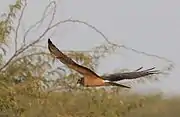Pallid harrier
The pale or pallid harrier (Circus macrourus) is a migratory bird of prey of the harrier family. The scientific name is derived from the Ancient Greek. Circus is from kirkos, referring to a bird of prey named for its circling flight (kirkos, "circle"), probably the hen harrier and macrourus is "long-tailed", from makros, "long" and -ouros "-tailed".[2]
| Pallid harrier | |
|---|---|
 | |
| Scientific classification | |
| Kingdom: | Animalia |
| Phylum: | Chordata |
| Class: | Aves |
| Order: | Accipitriformes |
| Family: | Accipitridae |
| Genus: | Circus |
| Species: | C. macrourus |
| Binomial name | |
| Circus macrourus S. G. Gmelin, 1770 | |
 | |
| Range of C. macrourus Breeding Passage Non-breeding | |
It breeds in southern parts of eastern Europe and central Asia and Iran and winters mainly in India and southeast Asia. It is a very rare vagrant to Great Britain and western Europe, although remarkably a juvenile wintered in Norfolk in the winter of 2002/2003. In 2017 a pair of pallid harriers nested in a barley field in the Netherlands; they raised four chicks.[3]
This medium-sized raptor breeds on open plains, bogs and heathland. In winter it is a bird of open country.
Description

This is a typical harrier, with long wings held in a shallow V in its low flight. It also resembles other harriers in having distinct male and female plumages. Adults measure 40–48 cm (16–19 in) long with a wingspan of 95–120 cm (37–47 in). Males weigh 315 g (11.1 oz) while the slightly larger females weigh 445 g (15.7 oz). The male is whitish grey above and white below, with narrow black wingtips. It differs from the hen harrier in its smaller size, narrower wings, paler colour, and different wing tip pattern. The female is brown above with white upper tail coverts, hence females and the similar juveniles are often called "ringtails". Her underparts are buff streaked with brown. It is best distinguished from the female hen harrier on structure. It is very similar to the female Montagu's harrier, but has darker and more uniform secondaries from below.
Diet
Pallid harriers hunt small mammals, lizards and birds, surprising them as they drift low over fields and moors.
The nest of this species is on the ground. Four to six whitish eggs are laid.
Gallery
.jpg.webp) Female
Female Egg, Collection Museum Wiesbaden
Egg, Collection Museum Wiesbaden Juvenile in flight, Little Rann of Kutch
Juvenile in flight, Little Rann of Kutch Female Taking off, Little Rann of Kutch
Female Taking off, Little Rann of Kutch Female feeding on Insect, Little Rann of Kutch
Female feeding on Insect, Little Rann of Kutch
References
- BirdLife International (2013). "Circus macrourus". IUCN Red List of Threatened Species. 2013. Retrieved 26 November 2013.
- Jobling, James A. (2010). The Helm Dictionary of Scientific Bird Names. London: Christopher Helm. pp. 109, 236. ISBN 978-1-4081-2501-4.
- The pallid harrier, a new breeding species for the Netherlands
Further reading
- Forsman, Dick (1995). "Field identification of female and juvenile Montagu's and Pallid Harriers" (PDF). Dutch Birding. 17 (2): 41–54.
External links
| Wikimedia Commons has media related to Circus macrourus. |
| Wikispecies has information related to Circus macrourus. |
- Pallid harrier species text in The Atlas of Southern African Birds
- Iran's Birds - Pallid Harrier (in Persian)
- BirdLife species factsheet for Circus macrourus
- "Circus macrourus". Avibase.

- "Pallid harrier media". Internet Bird Collection.
- Pallid harrier photo gallery at VIREO (Drexel University)
- Audio recordings of Pallid harrier on Xeno-canto.
